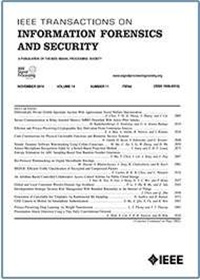Mind the Faulty Keccak: A Practical Fault Injection Attack Scheme Applied to All Phases of ML-KEM and ML-DSA
IF 8
1区 计算机科学
Q1 COMPUTER SCIENCE, THEORY & METHODS
IEEE Transactions on Information Forensics and Security
Pub Date : 2025-09-08
DOI:10.1109/TIFS.2025.3607242
引用次数: 0
Abstract
ML-KEM and ML-DSA are NIST-standardized lattice-based post-quantum cryptographic algorithms. In both algorithms,一种实用的故障注入攻击方案,适用于ML-KEM和ML-DSA的所有阶段
ML-KEM和ML-DSA是nist标准化的基于格子的后量子加密算法。在这两种算法中,Keccak是指定的散列算法,广泛用于获取敏感信息,使其成为攻击者的宝贵目标。在故障注入攻击领域,针对Keccak的研究很少,也没有充分探讨其对ML-KEM和ML-DSA安全性的影响。因此,许多攻击仍未被发现。在本文中,我们首先识别Keccak的各种故障漏洞,这些漏洞通过在实际的循环中止模型下操纵控制流来确定(部分)输出。然后,我们系统地分析了Keccak输出错误的影响,并提出了针对ML-KEM的六种攻击和针对ML-DSA的五种攻击,包括密钥恢复、签名伪造和验证绕过。这些攻击涵盖密钥生成、封装、解封装、签名和验证阶段,使我们的方案第一个应用于ML-KEM和ML-DSA的所有阶段。在嵌入式设备上运行的PQClean库的ML-KEM和ML-DSA的C实现上验证了所提出的攻击。实验表明,采用低成本的电磁故障注入设置,可以在ARM Cortex-M0+、M3、M4和M33微处理器上实现所需的环中断故障,成功率为89.5%。一旦故障注入成功,所有建议的攻击都可以以100%的概率成功。
本文章由计算机程序翻译,如有差异,请以英文原文为准。
求助全文
约1分钟内获得全文
求助全文
来源期刊

IEEE Transactions on Information Forensics and Security
工程技术-工程:电子与电气
CiteScore
14.40
自引率
7.40%
发文量
234
审稿时长
6.5 months
期刊介绍:
The IEEE Transactions on Information Forensics and Security covers the sciences, technologies, and applications relating to information forensics, information security, biometrics, surveillance and systems applications that incorporate these features
 求助内容:
求助内容: 应助结果提醒方式:
应助结果提醒方式:


